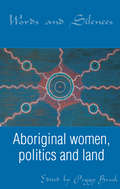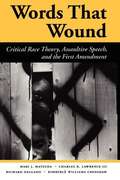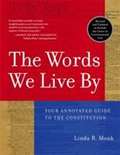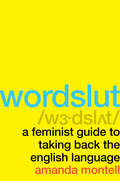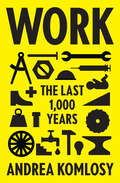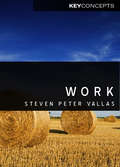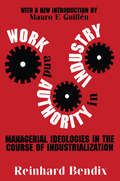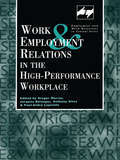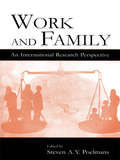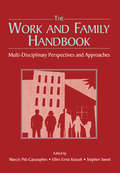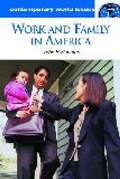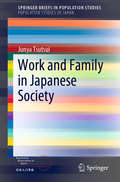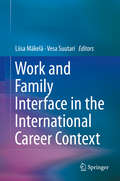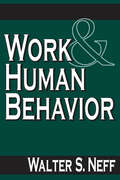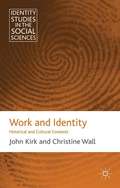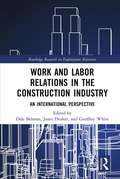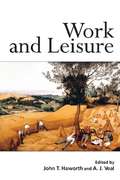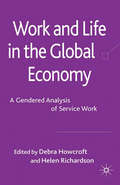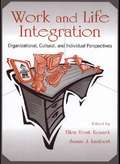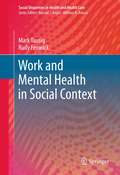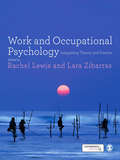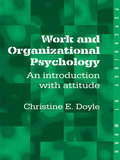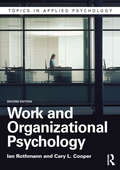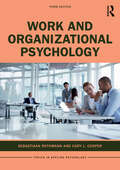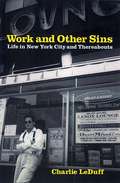- Table View
- List View
Words and Silences: Aboriginal women, politics and land
by Peggy BrockIn struggles over access to land, Aboriginal women's concerns have often remained unacknowledged. Their words - and silences - have been frequently misheard, misunderstood, misrepresented, misused.The controversy about 'secret women's business' in the Hindmarsh Island Bridge conflict has brought this issue to the attention of the general public. How can Aboriginal women assert their claims while protecting, by remaining silent, their culturally sensitive knowledge? How can they prevent their words and silences being misrepresented?Words and Silences explores the barriers confronting Aboriginal women trying to defend their land rights. The contributors to this volume provide insights into the intricacies of Aboriginal social and cultural knowledge, and introduce the reader to different understandings of how the gendered nature of Aboriginal land ownership adds complexity to the cross-cultural encounter. In lively and engaging prose they document the ongoing struggles of Aboriginal women across Australia, who are fighting to ensure they receive due recognition of their rights in land.
Words That Wound: Critical Race Theory, Assaultive Speech, and the First Amendment (New Perspectives on Law, Culture, and Society)
by Mari J. Matsuda Charles Κ Lawrence Richard Delgado Kimberle Williams CrenshawWords, like sticks and stones, can assault; they can injure; they can exclude. In this important book, four prominent legal scholars from the tradition of critical race theory draw on the experience of injury from racist hate speech to develop a first amendment interpretation that recognizes such injuries. In their critique of “first amendment orthodoxy,” the authors argue that only a history of racism can explain why defamation, invasion of privacy, and fraud are exempt from free-speech guarantees while racist and sexist verbal assaults are not.The rising tide of verbal violence on college campuses has increased the intensity of the “hate speech” debate. This book demonstrates how critical race theory can be brought to bear against both conservative and liberal ideology to motivate a responsible regulation of hate speech. The impact of feminist theory is also evident throughout. The authors have provided a rare and powerful example of the application of critical theory to a real-life problem.This timely and necessary book will be essential reading for those experiencing the conflicts of free-speech issues on campus—students, faculty, administrators, and legislators—as well as for scholars of jurisprudence. It will also be a valuable classroom tool for teachers in political science, sociology, law, education, ethnic studies, and women's studies.
The Words We Live By: Your Annotated Guide to the Constitution
by Linda R. MonkFrom the book: In this book, you will hear the voices of America's founders and fanatics, of Supreme Court justices and civil rights workers. Among this cacophony are rock star Ted Nugent, first-grader Ruby Bridges, actor Charlton Heston, gay rights activist Michael Hardwick, ex-con Clarence Earl Gideon, and pro-life protester Norma McCorvey. As these stories prove, the Constitution is not self-enforcing and depends upon citizens for its support. Judge Learned Hand emphasized this fact during World War II: I often wonder whether we do not rest our hopes too much upon constitutions, upon laws, and upon courts. These are false hopes; believe me, these are false hopes, liberty lies in the hearts of men and women; when it dies there, no constitution, no law, no court can save it. For the Constitution to have meaning, it must be not only the words we recite, but also the words we live by. [This text is listed as an example that meets Common Core Standards in English language arts in grades 6-8 at http://www.corestandards.org.]
Wordslut: A Feminist Guide to Taking Back the English Language
by Amanda MontellA brash, enlightening, and wildly entertaining feminist look at gendered language and the way it shapes us, written with humor and playfulness that challenges words and phrases and how we use them. <P><P>The word bitch conjures many images for many people, but it is most often meant to describe an unpleasant woman. Even before its usage to mean a female canine, bitch didn’t refer to gender at all—it originated as a gender-neutral word meaning genitalia. <P><P>A perfectly innocuous word devolving into a female insult is the case for tons more terms, including hussy—which simply meant housewife—or slut, which meant an untidy person and was also used to describe men. These words are just a few among history’s many English slurs hurled at women. <P><P>Amanda Montell, reporter and feminist linguist, deconstructs language—from insults and cursing, gossip, and catcalling to grammar and pronunciation patterns—to reveal the ways it has been used for centuries to keep women and other marginalized genders from power. Ever wonder why so many people are annoyed when women talk with vocal fry or use the word like as a filler? Or why certain gender-neutral terms stick and others don’t? Or where stereotypes of how women and men speak come from in the first place? <P><P>Montell effortlessly moves between history, science, and popular culture to explore these questions and more—and how we can use the answers to effect real social change. Montell’s irresistible humor shines through, making linguistics not only approachable but both downright hilarious and profound, demonstrated in chapters such as: <br>Slutty Skanks and Nasty Dykes: A Comprehensive List of Gendered Insults <br>How to Embarrass the Shit Out of People Who Try to Correct Your Grammar <br>Fuck it: An Ode to Cursing While Female <br>Cyclops, Panty Puppet, Bald Headed Bastard and 100+ Other Things to Call Your Genitalia <P><P>Montell effortlessly moves between history and popular culture to explore these questions and more. Wordslut gets to the heart of our language, marvels at its elasticity, and sheds much-needed light into the biases that shadow women in our culture and our consciousness.
Work: The Last 1,000 Years
by Loren Balhorn Andrea Komlosy Jacob WatsonTracing the complexity and contradictory nature of work throughout historyBy the end of the nineteenth century, the general Western conception of work had been reduced to simply gainful employment. But this limited perspective contrasted sharply with the personal experience of most people in the world—whether in colonies, developing countries or in the industrializing world. Moreover, from a feminist perspective, reducing work and the production of value to remunerated employment has never been convincing.Andrea Komlosy argues in this important intervention that, when we examine it closely, work changes its meanings according to different historical and regional contexts. Globalizing labour history from the thirteenth to the twenty-first centuries, she sheds light on the complex coexistence of multiple forms of labour (paid/unpaid, free/unfree, with various forms of legal regulation and social protection and so on) on the local and the world levels. Combining this global approach with a gender perspective opens our eyes to the varieties of work and labour and their combination in households and commodity chains across the planet—processes that enable capital accumulation not only by extracting surplus value from wage-labour, but also through other forms of value transfer, realized by tapping into households’ subsistence production, informal occupation and makeshift employment. As the debate about work and its supposed disappearance intensifies, Komlosy’s book provides a crucial shift in the angle of vision.
Work: A Critique (Key Concepts)
by Steven VallasThis book provides a critical overview of the myriad literatures on “work,” viewed not only as a product of the marketplace but also as a social and political construct. Drawing on theoretical and empirical contributions from sociology, history, economics, and organizational studies, the book brings together perspectives that too often remain balkanized, using each to explore the nature of work today. Outlining the fundamental principles that unite social science thinking about work, Vallas offers an original discussion of the major theoretical perspectives that inform workplace analysis, including Marxist, interactionist, feminist, and institutionalist schools of thought. Chapters are devoted to the labor process, to workplace flexibility, to gender and racial inequalities at work, and to the link between globalization and the structure of work and authority today. Major topics include the relation between work and identity; the relation between workplace culture and managerial control; and the performance of emotional labor within service occupations. This concise book will be invaluable to students at all levels as it explores a range of insights to make sense of pressing issues that drive the social scientific study of work today.
Work and Authority in Industry: Managerial Ideologies in the Course of Industrialization
by Richard BendixWork and Authority in Industry analyzes how the entrepreneurial class responded to the challenge of creating, and later managing, an industrial work force in widely differing types of industrial societies: the United States, England, and Russia. Bendix's penetrating re-examination of an aspect of economic history largely taken for granted was first published in 1965. It has become a classic. His central notion, that the behavior of the capitalist class may be more important than the behavior of the working class in determining the course of events, is now widely accepted. The book explores industrialization, management, and ideological appeals; entrepreneurial ideologies in England's early phase of industrialization; entrepreneurial ideologies in eighteenth- and nineteenth-century Russia; the bureaucratization of economic enterprises; and the American experience with -industrialization. This essential text will interest those in the fields of political science, industrial relations, management studies, as well as comparative sociologists and historians.
Work and Employment in the High Performance Workplace (Routledge Studies in Employment and Work Relations in Context)
by Jacques Bélanger Gregor Murray Anthony Giles Paul-André LapointeThere is a general consensus that deep-seated changes are reshaping the way production and work are organized, the way employees, employers and their representatives deal with each other, and the way governments seek to shape society. In this work a group of leading scholars take stock of the evidence and implications of the new workplace. Drawing on examples from a variety of national contexts, they seek to characterize the nature of contemporary workplace change, and assess its implications for the organization of work for workers, for employment relations and for public policy.
Work and Family: An International Research Perspective (Applied Psychology Series)
by Steven A. Y. PoelmansThe entrance of women into managerial positions in significant numbers brings work and family issues to center stage, shifting the spotlight from issues of entry and equality of access to the consideration of the work-family conflicts and the difficulties posed on female managers. Looking at new approaches to enhance the work-family interface individually and in the firm, Work and Family: An International Research Perspective:*provides an overview on the antecedents of work-family conflict and the major consequences of work-family conflict, for well-being, productivity, and the strength of the relationship with the firm;*discusses the migrant's work and family experiences in terms of the demands, opportunities, and constraints they face and the role of work-family culture in reconciling the demands of work and family in organizations;*presents descriptive data concerning the linkages between work-family pressure and several known correlates and the differences in reported levels of each of these variables;*explores the work-life balance challenges and opportunities created by global assignments;*examines the work-family interface of the Western model and urban sub-saharan Africa;*emphasizes the importance of organizational change to the dynamics of work-family policies; and*highlights the progress in moving the field toward an open-systems perspective.Written by well-known contributors, this book offers international research in order to test the models mostly developed in the United States. In addition, it develops new models to capture the complexity and diversity of work-family experiences around the globe and explores cross-cultural topics.
The Work and Family Handbook: Multi-Disciplinary Perspectives and Approaches
by Ellen Ernst Kossek Marcie Pitt-Catsouphes Stephen SweetThe Work and Family Handbook is a comprehensive edited volume, which reviews a wide range of disciplinary perspectives across the social sciences on the study of work-family relationships, theory, and methods. The changing demographics of the labor force has resulted in an expanded awareness and understanding of the intricate relations between work and family dimensions in people's lives. For the first time, the efforts of scholars working in multiple disciplines are organized together to provide a comprehensive overview of the perspectives and methods that have been applied to the study of work and family. In this book, the leading work-family scholars in the fields of social work, psychology, sociology, organizational behavior, human resource management, business, and other disciplines provide chapters that are both accessible and compelling. This book demonstrates how cross-disciplinary comparisons of perspective and method reveal new insights on the needs of working families, the challenges faced by those who study them, and how to formulate policy on their behalf.
Work and Family in America: A Reference Handbook
by Leslie F. Stebbins Mildred VasanThis reference provides students, researchers, human resource professionals, and activists with a balanced and detailed overview of the field of work-family. It reviews research in the field, chronicles work-family issues since 1800, and provides biographies of researchers currently active in the field. Important legislation and cases are reviewed, with particular emphasis on employment laws affecting women, and statistics are provided on work-family trends nationally and internationally. The reference includes descriptions and contact information for public and private organizations, annotated bibliographies of print, video, and Internet resources, and a glossary. The author teachers sociology and women's studies at Brandeis University.
Work and Family in Japanese Society (SpringerBriefs in Population Studies)
by Junya TsutsuiThis book provides a systematic framework for interpreting the fertility decline in Japan. It situates the change in fertility rates in a broader context, such as family life and working customs. The basic argument it puts forward is that Japan has failed to establish a “dual-earner” society: women still face the trade-off between having a career or starting a family, which has led to an extremely low fertility rate in Japanese society. Further to this rather common explanation, which could also be applied to other low-fertility societies such as Germany and Italy, the author presents an original view. Japan has had its own momentum in holding on to its strong “men as breadwinners and women as housekeepers” model by creating a unique regime, namely, a Japanese model of a welfare society. This regime places special emphasis on the welfare provided by private companies and family members instead of by the government. Private firms are expected to secure men’s jobs and income to the greatest extent, taking advantage of Japanese employment customs. On the other hand, women are expected to provide care for their family members. The book argues that the familialist orientation is still dominant in Japan and is repeatedly reinforced in the policy context.
Work and Family Interface in the International Career Context
by Liisa Mäkelä Vesa SuutariThis book focuses on the interface of work and personal life of international professionals. The globalization of business has led to an increasing number of people who work in international roles either through working abroad on different kinds of assignments or through international travelling. This book provides novel knowledge on the topic from different perspectives, highlighting not only the inherent challenges but also the positive side of working in a modern globalized world. Moreover, the book contributes by bringing together international professionals' own experiences, family members' experiences, organizational aspects and new theoretical discussions and models. The book covers several different perspectives on the work and personal life interface offering insights on the areas like adjustment, social support, dual-career issues and organizational practices. The book examines the situations of several different types of international employee such as organizational expatriates, self-initiated expatriates and international business travellers. The new interesting research evidence is provided from various country contexts from North America, Europe and Asia by researchers around the world.
Work and Human Behavior
by Walter NeffWork is a many-sided human enterprise that has been written about from a great many different points of view, representing almost every field of knowledge and almost every level of our social structure. Merely to identify these points of view is an impressive task. The subject of work has been written about by theologians and philosophers, by poets and novelists, by historians, economists, and sociologists, by biologists and naturalists, by politicians, by essayists and journalists. It has been described as both a blessing and a curse, as the chief means through which man has developed a high culture, and as a ravager of our natural environment. Following the preface, and an introductory chapter on the scope of the problem of work the title is divided up into four main sections, which include: The Nature of Work, Clinical Issues, Work and Mental Health, and Some Contemporary Problems Since the first two editions, new issues have arisen that are currently leading to a certain amount of public uproar. The first issue concerns the sources of worker productivity prompted by the current decline of preeminence of United States industry both in the world market and in certain aspects of our internal market. The second issue involves the complex relations between work and mental health, with work being viewed, on one hand, as a factor in the generation of insecurity and mental illness and, from another, as a factor in the treatment of the severe mental disorders. While much of the current published material on these two issues is characterized more by heat than by enlightenment, the third edition includes new chapters in these widely debated areas.
Work and Identity
by John Kirk Christine WallThis book presents an accessible and fascinating account of theoretical debates around identity and work, recent empirical trends and methodological arguments concerning the role of oral testimony and its interpretation. Focusing on three occupational sectors in particular teachers, bank workers and the railway industry it also presents an argument that is both more general than this and theoretically and analytically wide-ranging. The book explores some important questions: how are workers, both in the past and the present juncture, socialised into work cultures? What are the cultural and structural differences with regard the world of work across class, gender, and generation? What are the historical conditions of which these differences play a part? How is the idea of work found in a range of representations, from artistic production to sociological discourse expressed and explored? The development of concepts such as 'structures of feeling' and affect, and the weaving in of historical and visual material, make the book important to a wide range of readers including ethnographers, cultural sociologists and narrative researchers. In turn, this book offers an authoritative and sophisticated summary and analysis of work and identity and is an important intervention into mainstream sociology concerns.
Work and Labor Relations in the Construction Industry: An International Perspective (Routledge Research in Employment Relations)
by Dale BelmanThe need for a skilled, motivated and effective workforce is fundamental to the creation of the built environment across the world. Known in so many places for a tendency to informal and casual working practices, for the sometimes abusive use of migrant labor, for gendered male employment and for a neglect of the essentials of health and safety, the industry, its managers and its workforce face multiple challenges. This book brings an international lens to address those challenges, looking particularly at the diverse ways in which answers have been found to manage safe and productive employment practices and effective employment relations within the framework of client demands for timely and cost-effective project completions. Whilst context, history and contractual frameworks may all militate against a careful attention to human resource issues this makes them even more deserving of attention. Work and Labor Relations in Construction aims to share understanding of best practice in the industries associated with construction and related activities, recognizing that effective work organization and good standards of employee relations will vary from one location to another. It acknowledges the real difficulties encountered by workers in parts of the developing world and the quest for improvement and awareness of some of the worst hazards and current practices. This book is both critical and analytical in approach and seeks to alert readers to the need for change. Aimed at addressing practical issues within the construction industry from a theoretical and empirical standpoint, it will be of value to those interested in the built environment, employment relations and human resource management.
Work and Leisure
by A. J. Veal John T. HaworthGlobalization, economic development and changes in social environments have put the relationships between work, leisure, social structure and quality of life under the spotlight. Profound transformations in the nature and organization of work are occurring, with potentially far-reaching social and economic consequences. Increasingly, organizations demand greater flexibility from their workforces and are introducing new technologies and practices in response to global competitive pressures. At the same time many employees are experiencing long working hours, increasing workloads and job insecurity, along with the challenge of balancing work and domestic responsibilities. These changes threaten long-term gain in leisure time while, simultaneously, the leisure environment is also changing radically, as we see increasing commercialization and professionalization of leisure services and experiences, the influence of the Internet, the rise of gambling and the decline of community-based activity. Exploring all of these issues, this book brings together specially commissioned chapters from international experts in a wide range of disciplines concerned with work, leisure and well-being. Each author takes stock of the current position, identifies core practical and theoretical issues and discusses possible future trends in order to provide an invaluable resource for all policy-makers, educators, employers and researchers in the field.
Work and Life in the Global Economy
by Debra Howcroft Helen RichardsonThis book aims to explore the social and cultural issues within the economic changes that have given rise to service work. Written by specialists in their respective fields, this book draws together authors from interdisciplinary areas that are carrying out significant research into gender and service work within an international context.
Work and Life Integration: Organizational, Cultural, and Individual Perspectives (Applied Psychology Series)
by Ellen Ernst Kossek Susan J. LambertWork-family researchers have had much success in encouraging both organizations and individuals to recognize the importance of achieving greater balance in life. Work and Life Integration addresses the intersect between work, life, and family in new and interesting ways. It discusses current challenges in dealing with work-life integration issues and sets the stage for future research agendas. The book enlightens the research community and informs the public debates on how workplaces can be made more family sensitive by providing contributions from psychologists, sociologists, and economists who have not shied away from asserting the policy implications of their findings.This text appeals to both practitioners and academics interested in seeking ways to create meaningful lives.
Work and Mental Health in Social Context
by Mark Tausig Rudy FenwickAnyone who has ever had a job has probably experienced work-related stress at some point or another. For many workers, however, job-related stress is experienced every day and reaches more extreme levels. Four in ten American workers say that their jobs are "very" or "extremely" stressful. Job stress is recognized as an epidemic in the workplace, and its economic and health care costs are staggering: by some estimates over $ 1 billion per year in lost productivity, absenteeism and worker turnover, and at least that much in treating its health effects, ranging from anxiety and psychological depression to cardiovascular disease and hypertension. Why are so many American workers so stressed out by their jobs? Many psychologists say stress is the result of a mismatch between the characteristics of a job and the personality of the worker. Many management consultants propose reducing stress by "redesigning" jobs and developing better individual strategies for "coping" with their stress. But, these explanations are not the whole story. They don't explain why some jobs and some occupations are more stressful than other jobs and occupations, regardless of the personalities and "coping strategies" of individual workers. Why do auto assembly line workers and air traffic controllers report more job stress than university professors, self-employed business owners, or corporate managers (yes, managers!)? The authors of Work and Mental Health in Social Context take a different approach to understanding the causes of job stress. Job stress is systematically created by the characteristics of the jobs themselves: by the workers' occupation, the organizations in which they work, their placements in different labor markets, and by broader social, economic and institutional structures, processes and events. And disparities in job stress are systematically determined in much the same way as are other disparities in health, income, and mobility opportunities. In taking this approach, the authors draw on the observations and insights from a diverse field of sociological and economic theories and research. These go back to the nineteenth century writings of Marx, Weber and Durkheim on the relationship between work and well-being. They also include the more contemporary work in organizational sociology, structural labor market research from sociology and economics, research on unemployment and economic cycles, and research on institutional environments. This has allowed the authors to develop a unified framework that extends sociological models of income inequality and "status" attainment (or allocation) to the explanation of non-economic, health-related outcomes of work. Using a multi-level structural model, this timely and comprehensive volume explores what is stressful about work, and why; specifically address these and questions and more: -What characteristics of jobs are the most stressful; what characteristics reduce stress? -Why do work organizations structure some jobs to be highly stressful and some jobs to be much less stressful? Is work in a bureaucracy really more stressful? -How is occupational "status" occupational "power" and "authority" related to the stressfulness of work? -How does the "segmentation" of labor markets by occupation, industry, race, gender, and citizenship maintain disparities in job stress? - Why is unemployment stressful to workers who don't lose their jobs? -How do public policies on employment status, collective bargaining, overtime affect job stress? -Is work in the current "Post (neo) Fordist" era of work more or less stressful than work during the "Fordist" era? In addition to providing a new way to understand the sociological causes of job stress and mental health, the model that the authors provide has broad applications to further study of this important area of research. This volume will be of key interest to sociologists and other researchers studying social stratification, public health, political economy, institutional and organizational theory.
Work and Occupational Psychology: Integrating Theory and Practice
by Rachel Lewis Lara ZibarrasWork and Occupational Psychology is the ideal companion for any student of the field, whether they are studying for a postgraduate qualification with a view to working in OP, or taking the subject as part of a wider degree programme at any level.<P><P> Written by a team of experts and with contributions from seminal academics and leading practitioners, this text provides the concise link between theoretical learning and the key practical skills needed to increase your grades and your employability.<P> Features of this book include:<P> - Structured around the eight core areas of Occupational Psychology to ensure a rounded overview and enables students to dip in and out of the text<P> - Assumes no prior knowledge of the subject making it ideal for anyone studying Occupational Psychology for the first time<P> - Provides a contemporary and future-facing account of the field, including cutting edge research and reflections on future of Occupational Psychology<P> - Reflects the realities of a global workplace through discussion of international and cross-cultural issues and a range of international case studies<P> - Engages critically with the subject to encourage analytical thinking<P> - Comes with a range of accessible in-text and online learning features including essay/exam questions, access to full text SAGE journal articles, podcasts and a glossary.<P> Visit the Companion Website at www.sagepub.co.uk/zibarras
Work and Organizational Psychology: An Introduction with Attitude
by Christine DoyleIn this unique text, Christine Doyle provides the student with a cutting-edge introduction to the field of work and organizational psychology. The main focus is on recent changes that have occurred in the world of work, incorporating their causes, consequences, proposed solutions to the associated problems, and above all, the challenges they pose for work and organizational psychology.Among the topics covered are motivation at work, the concept of stress, and the causes of individual accidents and organizational disasters. Solutions to such problems might include lifelong learning and training, performance management, career development, and employee assistance programmes.This lively, provocative, and highly readable book will be an essential resource for advanced undergraduate and postgraduate students of work and organizational psychology, as well as business management students, managers and anyone with an interest in human resources management.
Work and Organizational Psychology
by Ian Rothmann Cary L. CooperPsychologists have been fascinated by the world of work, and the changing relationship between people, technology and the workplace, since the onset of the industrial revolution. And in providing a complete and contemporary overview of this evolving and fascinating field, the new edition of Work and Organizational Psychology is the perfect textbook, outlining not only the key theoretical ideas, but also how they relate to the role of psychologists advising today’s organizations. The only textbook to integrate the fields of HRM and organizational behaviour, the new edition is thoroughly revised to cover new technological advances such as virtual workplaces and virtual employees. In an era of rapid socio-economic change, there is also expanded coverage of the role of workplace diversity, employee commitment and globalization, as well as updated chapters on key concepts such as motivation, leadership, group behaviour and well-being at work. Also including a chapter on career development, the book is supported by a range of pedagogical features, spotlighting issues of theoretical, ethical or contemporary interest, whilst also enabling students to engage in active learning. Lucid and comprehensive, the second edition of Work and Organizational Psychology will be the cornerstone for any student of this dynamic field.
Work and Organizational Psychology (Topics in Applied Psychology)
by Sebastiaan Rothmann Cary L. CooperProviding a complete and contemporary overview of the evolving and fascinating world of work, this new edition of Work and Organizational Psychology is the perfect textbook, outlining not only key theoretical ideas, but how they relate to the role of psychologists advising today’s organizations. Integrating the fields of human resource management and organizational behaviour, the text begins with a chapter to give the reader an insight into the domain of work and organizational psychology, the development of the field of work and organizational psychology, tasks and competencies of organizational and work psychologists, and careers in work and organizational psychology. The remainder of the book is divided into thirteen chapters which address the core areas of work and organizational psychology. The book is supported by a range of pedagogical features, spotlighting issues of theoretical, ethical, or contemporary interest, whilst also enabling students to engage in active learning.
Work and Other Sins: Life in New York City
by Charles LeduffWork and Other Sins is filled to burst with stories of the fascinating, one-of-a-kind characters who populate the modern metropolis. In these pages we meet a Long Island used-car salesman; a professional Santa; the men who change the light bulbs atop the Empire State Building; a Sinatra imitator; a retired Harlem chorus-line girl; a lighthouse keeper; a saloon priest; Latin lovers; a host of barroom regulars; and myriad others-all of whom present their take on working, drinking, gambling, dying, and countless other facts of life. Charlie LeDuff takes us to the watering holes, prisons, veterans' hospitals, firehouses, apartment buildings, baseball fields, and graveyards that make up the landscape of modern life. Also included is LeDuff's acclaimed series of articles on Squad One, the Brooklyn firehouse that suffered devastating losses on September 11, as well as his Pulitzer Prize-winning piece on workers in a North Carolina slaughterhouse. LeDuff captures the spirit of the people and places he profiles with a dead-on feel for character and idiom and his signature wry wit. But more than that, LeDuff lets his characters speak for themselves. What results is at turns riotous, dirt-under-the-nails, contemplative, salty, joyous, whiskey tinged-an utterly unique vision of life in the Big Apple and beyond.
